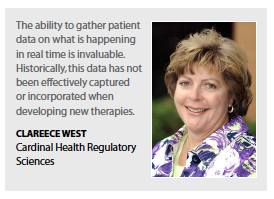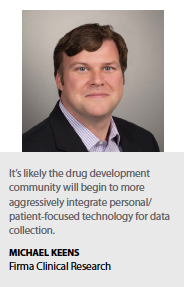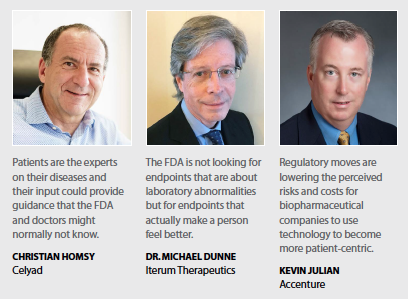Regulators are working to make sure patients have a seat at the clinical trial table.
The Food and Drug Administration has been instrumental in the movement toward patient-centric clinical trial initiatives and driving these initiatives forward is the future of trial development. In recent years, the FDA has accelerated its public support of patient involvement and awareness into the drug development process.
Whether by the establishment of the Patient Engagement Advisory Committee (PEAC) in 2015  by then FDA Commissioner Robert Califf, or the more recent discussions by the recently departed FDA Commissioner Scott Gottlieb on Decentralized Clinical Trials in January 2019, these endorsements of patient involvement should provide pharma companies the ability to undertake patient-focused initiatives more confidently and with less perceived risk or uncertainty in drug development.
by then FDA Commissioner Robert Califf, or the more recent discussions by the recently departed FDA Commissioner Scott Gottlieb on Decentralized Clinical Trials in January 2019, these endorsements of patient involvement should provide pharma companies the ability to undertake patient-focused initiatives more confidently and with less perceived risk or uncertainty in drug development.
“It’s likely, given the level of engagement already demonstrated by former Commissioner Gottlieb in particular, the FDA will begin to support its desire for pharma companies to incorporate technology and data collection away from the investigative site through a series of more formalized development guidance documents," says Michael Keens, chief operating officer, Firma Clinical Research. “With this public support, and soon-to-follow guidance documents, it’s likely the drug development community will begin to more aggressively integrate personal/patient-focused technology for data collection, reduce the number of office visits with technology and home care visits, and increase the level of patient participation in clinical trials, thereby accelerating drug development."
Patients are increasingly becoming experts in their own conditions and strong advocates for their health, particularly in rare disease. They want to be involved in every decision made about their healthcare and have the same expectation for clinical research.
“The relationship is moving to one of partners, rather than benefactor and recipient," says Marie Lux, senior director, global patient and site solutions, IQVIA. “This is reflected in the FDA’s establishment of the Patient Engagement Collaborative and its commitment to work with patients, caregivers, and advocates to incorporate their various perspectives into the regulatory decision-making process."
She says active, engaged patients — those most likely to enroll in clinical studies — will require that the research in which they participate is focused on the things that matter most to them. “For this to occur, early involvement in the study development process is needed," Ms. Lux says.  “Patients are also likely to want to manage their own health data through an increasing range of tools and have the ability to choose with whom and when they share it."
“Patients are also likely to want to manage their own health data through an increasing range of tools and have the ability to choose with whom and when they share it."
Michael Dunne, M.D., chief scientific officer, Iterum Therapeutics, says there’s a mandate for the FDA to ensure that primary endpoints include how the patient feels, functions, or survives.
“This component of the primary endpoint needs to be very carefully addressed with the regulators," he says. “Regulators are not looking for endpoints that just focused on laboratory abnormalities but for endpoints that actually make a person feel better. Pharmaceutical companies will need to pay much more attention to the patient’s interpretation of his or her therapeutic experience to be sure that the products that are being brought forward are tailored to what the patient, and not just the doctor, may see as important."
Recent Efforts
The FDA’s recognition for the need of the voice of the patient to be incorporated in drug development and evaluation is critical, as many biopharmaceutical R&D organizations are risk-averse in their approaches and will be encouraged to explore new approaches by the regulatory guidance.
From 2012 to 2017, under the fifth authorization of PDUFA (PDUFA V), the FDA conducted 24 disease-specific patient-focused drug development (PFDD) meetings to more systematically obtain the patient perspective on specific diseases and their treatments.
“This initiative provided an opportunity to better incorporate patient perspectives and experiences, and have a better understanding of what it’s like to live with these conditions on an intimate level," says Clareece West, VP and general manager, Cardinal Health Regulatory Sciences. “The ability to gather patient data on what is happening in real time is invaluable.
Historically, this data has not been effectively captured or incorporated when developing new therapies. As these first-hand, real-world accounts are implemented into the drug development process, the industry will move closer toward true patient-centricity than ever before, which will ultimately translate into therapeutic advances and improved patient outcomes."
Ms. West says as the FDA continues to develop pathways for technology-enabled information, the agency will continue to use benefit-risk assessments in regulatory review and approval processes. “As a result, manufacturers and developers will need to build patient- and disease-centric tools into their processes to capture disease severity and identify any current unmet medical needs to determine benefit-risk considerations," she says.
The FDA has been very open to attending external pharma PFDD meetings on a case-by-case basis, says Karen Josey, VP, business development, VMS BioMarketing. “However, until patient-focused education and support become common practice in every clinical trial, our industry will not be truly patient-centric," she says.
An example of the FDA’s ongoing and supportive stance on using the latest technologies and methods — applications, devices, artificial intelligence — was highlighted during a Jan. 28, 2019, panel discussion with former FDA Commissioner Gottlieb, where he discussed an upcoming “Framework for Real-World Evidence Program." During his tenure Dr. Gottlieb had repeatedly emphasized improving the process for getting technology and therapies to patients. For example, in 2017 he introduced a pre-cert pilot program that proposed to allow certain companies that the FDA has deemed responsible and safe to build products without each new device undergoing the FDA clearance or approval process.
“These moves lower the perceived risk and costs for biopharmaceutical companies to use technology to become more patient-centric," says Kevin Julian, senior managing director, life sciences, Accenture.
In June 2018, the FDA issued its first draft guidance on gathering patient input on the collection of patient experience data, and the use of such data and related information in drug development. In it, the agency detailed how drugmakers can gather comprehensive and representative input from patients. The guidance is the first of a four-part series of guidances required under the patient-focused drug development component of the 21st Century Cures Act and is meant to provide methodological recommendations for how to collect and submit information gathered from patients and caregivers as part of regulatory submissions.
The FDA is also developing guidance related to submitting patient experience data. The FDA is developing these guidances over a five-year period in accordance with provisions included in the 21st Century Cures Act and to fulfill commitments under the sixth authorization of the Prescription Drug User Fee Act.
The guidance provides recommendations for both qualitative and quantitative research methods for analyzing patient experience data, as well as advice on how to operationalize and standardize data collection and data management.
The next guidances in the series will focus on what questions to ask patients and caregivers and how to ask them; how to decide what patient-focused outcomes to measure in a clinical trial; and how to determine an appropriate clinical trial endpoint using a patient-focused clinical outcome assessment.
“All of these recent policy regulations help elevate the patient’s voice in the clinical development process and send a strong message to both the medical and research communities and the pharmaceutical industry that patients are the key stakeholders in the decision-making process," says Gissoo DeCotiis, senior director, patient advocacy, Daiichi Sankyo.
In addition to developing guidance on patient-focused drug development, the FDA is committed to creating a repository of patient-focused drug development tools and hosting a public  workshop aimed at gathering input from the patient and caregiver community on approaches to enhance patient engagement in clinical trials.
workshop aimed at gathering input from the patient and caregiver community on approaches to enhance patient engagement in clinical trials.
The ultimate implication of these initiatives is to ensure that the medicines that are developed can be demonstrated to address aspects known to be important to patients, ensuring their successful acceptance when used in routine care, says Bill Byrom, Ph.D., VP, product strategy and innovation, CRF Bracket.
“It is fundamental to develop a robust understanding of the impact of disease and its treatment in the view of the patient," he says. “It’s equally important to understand patients’ perspective on aspects of treatment, such as their minimum threshold expectation of treatment benefits, their level of tolerance toward side effects, and acceptable trade offs between risk and benefit associated with treatment. This knowledge will lead to a greater need for qualitative and quantitative research work in the early phases of drug development to obtain patient experience data to support the later study designs."
Celyad CEO Christian Homsy says these efforts could lead the industry and the FDA to reevaluate the way treatments for some disorders are being developed and could allow for other alternatives or endpoint options that take the patient voice into consideration.
“We hope these efforts will open new discussions between patients, regulatory authorities, and industry on how to develop endpoints for certain difficult-to-treat disorders that will have a real-world impact on patients," Mr. Honsey says. “Patients are the experts on their diseases and their input could provide guidance that the FDA and doctors might normally not know. These initiatives truly introduce a new era of drug development and we look forward to keeping the focus on patients as we further develop our own pipeline."(PV)
~~~~~~~~~~~~~~~~~~~~~~~~~
FDA Efforts for Patient-Focused Drug Development
Patient-focused drug development (PFDD) is a systematic approach to help ensure that patients’ experiences, perspectives, needs, and priorities are captured and meaningfully incorporated into drug development and evaluation. As experts in what it is like to live with their condition, patients are uniquely positioned to inform the understanding of the therapeutic context for drug development and evaluation.
The primary goal of patient-focused drug development is to better incorporate the patient’s voice in drug development and evaluation by:
Facilitating and advancing use of systematic approaches to collecting and utilizing robust and meaningful patient and caregiver input to more consistently inform drug development and regulatory decision-making;
Encouraging identification and use of approaches and best practices to facilitate patient enrollment and minimizing the burden of patient participation in trials;
Enhancing understanding and appropriate use of methods to capture information on patient preferences and the potential acceptability of tradeoffs between treatment benefit and risk outcomes; and Identifying the information that is most important to patients related to treatment benefits, risks, and burden, and how to best communicate the information to support their decision making.
The agency is developing a series of four guidance documents to address how stakeholders can collect and submit patient experience data and other relevant information from patients and caregivers for medical product development and regulatory decision making. This series of guidance documents is intended to facilitate the advancement and use of systematic approaches to collect and use robust and meaningful patient and caregiver input that can better inform medical product development and regulatory decision making.
The first draft guidance was issued in June 2018 and addresses how drugmakers can gather comprehensive and representative input from patients. The draft guidance includes recommendations for drugmakers looking to incorporate patient experience data and other patient-focused information into their drug development programs, focusing specifically on who such information should be gathered from, and how that information is collected.


















